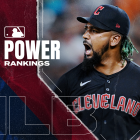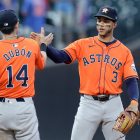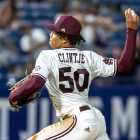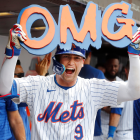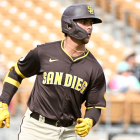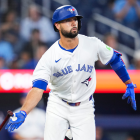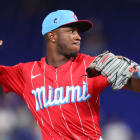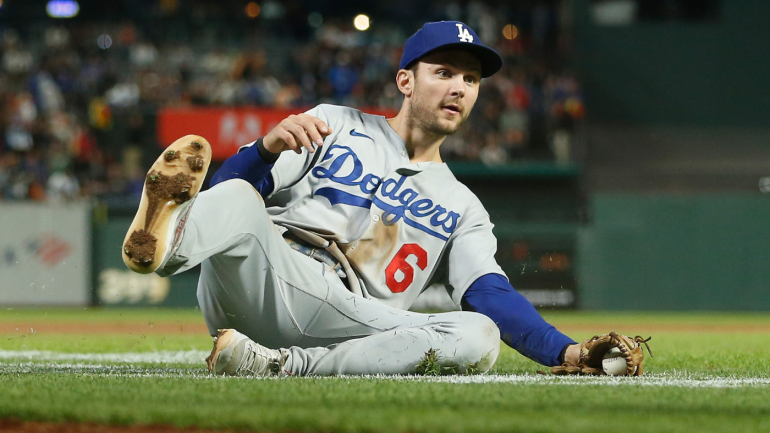
Savvy shoppers know that it's never too early to start planning ahead. There are five weeks remaining in Major League Baseball's regular season, meaning we're at least two months away from the start of free agency. Still, with Labor Day upcoming, we figured this would be a good time to preview the winter's class -- and to give fans of noncompetitive teams some hope about who might be on their roster next year.
Below, you'll find our first draft of the class' top 20 free agents. As always, the rankings are based on an unscientific combination of a player's true talent level (how they can reasonably be forecasted to perform in the future) and their expected annual average value. Players with options were included (or excluded) using the following rule of thumb: all team options are exercised; all player options are not. That's not realistic -- some players will opt in and some teams will opt out -- but it's a fairer solution than leaving it up to our read on a situation this far out.
Do note that these rankings are subject to change between now and the official publication of our top 50 list. There are games left to be played, after all.
Let's get to the list.
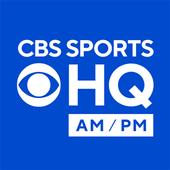
CBS Sports HQ Newsletter
Your Ultimate Guide to Every Day in Sports
We bring sports news that matters to your inbox, to help you stay informed and get a winning edge.
Thanks for signing up!
Keep an eye on your inbox.
Sorry!
There was an error processing your subscription.
1. Aaron Judge, OF, New York Yankees
Judge raised eyebrows in the spring when he rejected an extension offer worth $213 million. Front-office types were quick to point to his advanced age (he'll turn 31 next April) and his injury history as reasons he should've taken the deal. As it turns out, he was right to bet on himself. He's in the midst of possibly the finest walk season in history, a campaign that could soon double as the league's first 60-homer effort in two decades. That Judge is closing in on Roger Maris while primarily playing center field speaks to his unusual blend of power and athleticism. He isn't Richie Sexson or Kyle Blanks or some other lumbering giant of the past. He isn't a one-year wonder, either. The only person to accumulate more WAR than Judge during the Pandemic Era is Paul Goldschmidt -- and he might win the National League Triple Crown. Judge can't change his age or his injury history, but he's done everything within his power (literally) to boost his stock. He should be rewarded handsomely for it come winter.
2. Nolan Arenado, 3B, St. Louis Cardinals
Arenado has reportedly signaled that he doesn't intend to opt out of his current contract with St Louis. Fair enough. Our blanket treatment of these situations means that he gets a spot on here regardless. Arenado is in the midst of a phenomenal season, one that's being overshadowed only by teammate Paul Goldschmidt. He's a little older than some of the position players to follow, so you could argue he should be lower on the list. The rise in popularity of the short-term, AAV-heavy deal makes us put him here anyway. But again, none of this may matter on the final list if Arenado decides he's content with his situation.
3. Trea Turner, SS, Los Angeles Dodgers
Statistically, Turner has been one of the handful of best position players in the majors during the Pandemic Era. It's easy to understand how. He remains a tolerable shortstop option who has consistently hit for a high average while providing above-average power and speed production. To wit, if 20/20 seasons were 19/20 seasons, they wouldn't sound as cool but Turner would have three of them instead of one. (He's on the cusp of a second.) There are some drawbacks to Turner's game worth mentioning: He might have to move across the bag at some point during his next contract, and he's whiffed and chased more frequently this season than usual. Neither spells doom for him, at least not yet; both do merit monitoring, however.
4. Jacob deGrom, RHP, New York Mets
Although deGrom went more than a year in between appearances because of various injuries, and although he's yet to crack 200 combined innings since the start of the 2020 season, he's reaffirmed that he intends to opt out this winter. With the way he's performed since returning to the Mets rotation this month, why not? What's clear is that he feels confident he can fetch more than the two years and $65 million remaining on his contract. (Half of that is tied up in a club option.) What's unclear is if deGrom will be able to secure his payday as part of a long-term contract, or if the combination of his age (he's 34) and his recent absences will ferry him toward a shorter, AAV-heavy deal, similar to the one Max Scherzer signed last winter.
5. Carlos Correa, SS, Minnesota Twins
Remember, we're assuming that everyone who can opt out will opt out. Correa signed a three-year pact with the Twins last offseason that amounted to a series of one-year deals, each worth $35.1 million. Should he again test the market, he'll get to choose once more between maximizing his earnings and securing a long-term home. Either way, it'll be interesting to see how Correa is received this winter. He's having nearly the same offensive campaign as he did last year when his numbers are adjusted for his run-scoring environment, yet his month-to-month splits have deviated more than they did in 2021. Bill James once theorized that players who start hot are perceived better than players who end hot, since the former route allows the player's numbers to look better for longer. Is there a similar psychic effect working against players who swing between hot and cold months? Perhaps we'll find out this winter.
6. Justin Verlander, RHP, Houston Astros
Verlander is currently out with a calf injury, but he's had a remarkable season coming back from Tommy John surgery. His contract includes a player option worth $25 million for next season. Assuming he pitches on -- and why wouldn't he? -- he should receive at least that in AAV over another short term.
7. Xander Bogaerts, SS, Boston Red Sox
Bogaerts needn't look further than his own double-play partner, Trevor Story, to know that he can do better than the three years and $60 million remaining on his contract. (Story, for reference, received a $23 million AAV last offseason.) He's been a reliably well-above-average hitter for the last five seasons and he's done well to remain at shortstop this deep into his career. If there's one bugaboo here (beyond the possibility that he slides to third base or another position) it's that his power production is at its lowest since 2017. Bogaerts recently disclosed that he's been dealing with shoulder and wrist woes since colliding with a teammate in May. It would seem more reasonable than not to assume those developments are related.
8. Carlos Rodón, LHP, San Francisco Giants
We were bearish on Rodón last offseason because of his lengthy injury history and his scant record of being a dominant force in the majors. The league may have shared our reservations, as he ended up signing a two-year deal with the Giants that included a vesting player option if he cleared 110 innings. (Clearly he did.) Some mistakes you have to make only once. Rodón has again struck out nearly a third of the batters he's faced by following a simple formula: fastballs up, sliders down. There's not much more to it, just sheer force. Power left-handed starters are always in demand, and we suspect that Rodón will not suffer for long-term offers this winter.
9. Dansby Swanson, SS, Atlanta Braves
Swanson runs the risk of being overshadowed by the bigger-name shortstops in this class. It shouldn't be lost on anyone that he's developed into the kind of performer teams would be happy to take at No. 1. He's been an above-average hitter in two of the last three seasons (the exception saw him homer 27 times), and he's a more-than-capable defensive shortstop. Factor in how Swanson receives praise for being a leader in the clubhouse, and there's a lot to like about him and his game. If there is one glowing big-picture concern about him, it's the frequency with which he swings and misses. Swanson ranks 133rd out of the 144 qualifying batters in contact rate, putting him down there with the likes of Nelson Cruz, Josh Donaldson, and Nick Castellanos. In the interest of full disclosure, top-shelf rookies like Julio Rodríguez and Jeremy Peña are right around his contact rate. The difference is that they're a fair amount younger, giving them a longer runway before they start to have their bat speed, hand-eye coordination, and other physical skills diminish. Swanson will turn only 29 next February, so he still has some good years ahead of him. We just wonder if the back-end of his inevitable long-term deal could become hairier than you'd think.
10. Brandon Nimmo, CF, New York Mets
Where have all the good center fielders gone? The trade market was barren this deadline, and this winter's crop isn't great, either. Nimmo is the exception. He's a prototypical leadoff hitter who commands the strike zone and who has a good feel for contact. Some of the advanced defensive metrics are fond of his work on the grass, too, particularly when he has to charge in to make the play. The catch with Nimmo is his availability. He made his big-league debut in 2016, yet this year is just the second in which he's cleared the 100-game threshold. (He did play in 55 of the Mets' 60 games in 2020.) There's also the matter of whether or not these Mets would allow a quality starter to depart for greener pastures without a true successor in place. Perhaps those factors will counterbalance one another.
11. Willson Contreras, C, Chicago Cubs
It's one thing to write that Contreras is among the best hitting catchers in the majors, it's another to illustrate it. Here's our attempt: he's hit so well this season that his production is on par with the likes of Matt Olson and Rhys Hoskins, two highly regarded first basemen. Why isn't Contreras higher on this list? We're not sure if anyone will pay him what he's worth because of the league's defensive predilections. He has a strong arm and he's obsessed with attempting backpicks, yet he ranks in the 29th percentile in framing, according to Statcast. Front offices will stomach all-mitt catchers because they're an efficient way to add runs by improving the pitching staff. The inverse profile, the one Contreras sports, isn't as enticing for two obvious reasons: 1) he won't get your pitchers beneficial calls; and 2) you have to actually pony up for offense. Will someone do that for Contreras? Again, we're skeptical.
12. Clayton Kershaw, LHP, Los Angeles Dodgers
We just went through this last winter with Kershaw. Despite rumors that he might join the Rangers, the closest thing he has to a hometown team, he elected to remain with the Dodgers for another season. Whether or not Kershaw entertains heading to Arlington this winter is to be seen. For as well as he's performed, his price is likely to remain reasonable because of his limited availability: both in terms of his health and his (seeming) unwillingness to entertain offers from other teams.
13. Edwin Díaz, RHP, New York Mets
Díaz is the best reliever on the market. He has it all. An electric slider-fastball combination. An unreal ability to get down the mound (his release point is more than seven feet in front of the pitching rubber). A made-for-television entrance. And, presumably, a great chance at toppling Liam Hendriks' $18 million AAV, the highest ever awarded to a relief pitcher. Díaz is even in pursuit of Aroldis Chapman's single-season record for highest strikeout-per-nine rate. In other words, his fielders are free to make like Lupe Fiasco and end their nights right where the horns are.
14. José Abreu, 1B, Chicago White Sox
Our guess is that Abreu's winter will play out similarly to the one he experienced in 2019, his first foray into free agency. If you're drawing a blank on what happened it's for good reason: it didn't take long for him to accept the White Sox's qualifying offer. (The two sides subsequently agreed to a multi-year pact.) Should Abreu actively test the waters, he'll make for an interesting case study. He's remained a highly productive hitter, and he's sporting would-be career-best walk and strikeout rates. He's also a 35-year-old right-right first baseman who is on pace to finish with a career-low home-run total. That doesn't sound like the kind of profile that other teams are going to break the bank for, leaving the White Sox in the catbird seat.
15. Anthony Rizzo, 1B, New York Yankees
Rizzo was a free agent last offseason when he signed a two-year pact with the Yankees. The deal allows him to opt out after this season, and it seems reasonable to think he will, given how he's exceeded expectations. Rizzo is having his most productive effort since 2019 as judged by OPS+. He's also on the verge of delivering his first 30-homer campaign since 2017, or the year after the Cubs won the World Series. A lot has changed since then. Rizzo is no longer one of the youthful faces of a potential dynasty; he's a 33-year-old first baseman with a history of back concerns. This might be his last chance for multiple years, and he should take advantage of the situation.
16. Michael Brantley, OF/DH, Houston Astros
Brantley underwent a season-ending shoulder surgery earlier this month, complicating his free agency. He will always hit, but he's getting up there in age (he'll turn 36 early next season) and there's no telling if his shoulder will have a lasting effect. He seems like a good candidate for a lucrative one-year deal, be it as part of a return to the Astros or in joining some other contender looking for a lefty stick.
17. Andrew Heaney, LHP, Los Angeles Dodgers
Heaney is almost certain to be a misrank, either high or low. He's been brilliant when he's pitched this season, but he's appeared only nine times. There are compelling reasons to believe he's improved in sustainable ways, including the implementation of a sweeper and refined mechanics, but he's appeared only nine times. And so on. (Did we mention that he's appeared only nine times?) If we had to guess, the most likely outcome here is him re-signing with the Dodgers on a short-term deal that provides him a chance to Prove It before he gets his big payday. Perhaps we're mistaken in that respect. It almost surely won't be the last time we're wrong here.
18. Chris Bassitt, RHP, New York Mets
Bassitt technically signed an extension with the Mets in May that allowed the two sides to avoid arbitration. The pact included a $19 million mutual option for next season that, in a sense, doubled as an insurance policy. If Bassitt (who, in approaching his 34th birthday, is older than you think he is) hurt himself or his stock this summer, then at least he could stand to make bank next year on what amounted to a pillow contract. There's little reason to think that his side of the option will get exercised. He missed a week in July with a non-injury designation, and he's now closing in on a career-high amount of innings. The quality of his work has remained high, too. This could be the last contract he signs as a big-league player. He should aim high.
19. J.D. Martinez, DH, Boston Red Sox
There appear to be several red flags with Martinez. His OPS+ is the lowest it's been for a regulation-length season since he was with the Astros. His homer total is barely higher than it was in 2020 despite him appearing in twice as many games. He just celebrated his 35th birthday. And yes, he continues to offer negative secondary value. Nevertheless, Martinez's ball-tracking data suggests his bat is healthier than all the above information makes it sound: he still hits the ball hard (albeit not as hard and not as frequently as he used to) and he launches it within that sweet, sweet 10-to-30-degree window about as often as anyone in the game. In some respects, Martinez could be this winter's Anthony Rizzo: a veteran who might have one big year left in them. You just have to be willing to take the risk to find out for sure.
20. Nathan Eovaldi, RHP, Boston Red Sox
Eovaldi, currently out with lower back inflammation, is a tough pitcher to place. He's been an above-average starter for most of the last four seasons, but there are some signs of decay present in his game. He lost another mile per hour off his fastball this season, and his quality-of-contact data got worse. Yes, Eovaldi has always been more prone to loud contact than the average bear; so far this year, however, nearly 48 percent of his batted balls allowed have had an exit velocity north of 95 mph. For perspective, his rate in that same category over the last four seasons was 38.6 percent. Teams will have to decide if that's a blip or a slip before they pony up.










